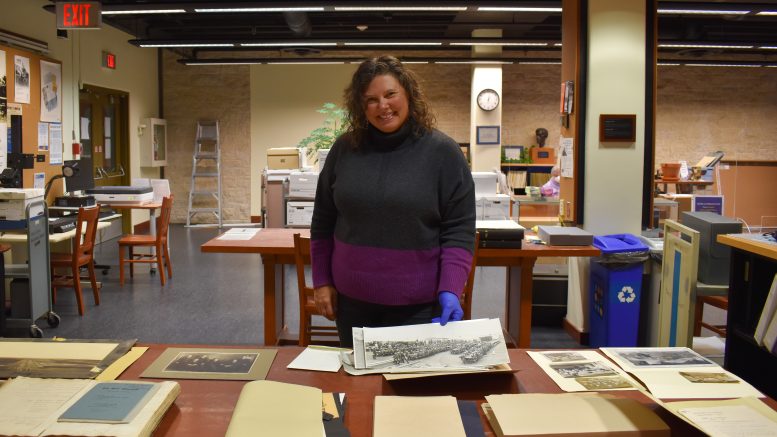
Head of Archives & Special Collections Heather Bidzinski stands alongside pieces from the archives. Photo by Faith Peters.
The Manitoban: A journey into U of M’s ‘untapped treasure’
Campus Archives & Special Collections holds university’s history
In a room on the third floor of Dafoe library, right beside the Icelandic reading room, a small group of archivists work to preserve history.
Since its establishment in 1877, life at the University of Manitoba has reflected the lives of students and faculty from across the province. Those lives and their histories have been preserved by the U of M Archives & Special Collections.
Head of Archives & Special Collections Heather Bidzinski said that the archives, though only an official unit of the university library since 1978, holds records dating back to before the university officially existed.
Bidzinski, the third-ever head in the archive’s history, emphasized the necessity of having archives to look back to.
“It’s important for us to know where we came from in order to make progress in the future,” she said.
Despite working with the past, Bidzinski said that somehow, there’s always something new to be discovered.
“Sometimes you open a box and you’ll find the most amazing pieces of history there.”
Bidzinski highlighted that, fitting for Manitoba and its constituents, part of the archive’s large collection pertains to agriculture. The current Fort Garry campus of the university was originally the site of the Manitoba Agricultural College, which would eventually become the U of M’s faculty of agriculture and food sciences.
While many items and documents in the archives are digitized, Bidzinski pulled aside some physical pieces from its collections. One visitors book belonging to the archive holds the signatures of major historical figures who visited the university, such as England’s King George V and Queen Mary — then the Duke and Duchess of Cornwall and York — and later, Albert Grey, the fourth Earl Grey and governor general of Canada.
Through the archives, one can get a glimpse not only into U of M history, but also into how world history has been observed through the lens of the university, its students and its faculty.
While continuing to offer studies after 1914 in fields such as arts, sciences, agriculture, home economics and law through its sponsorship of the newly founded law school, the U of M added programming to suit the needs of the First World War. The university council established its committee on military instruction, which allowed the teaching of military tactics and science. It also formed a university corps, which organized practise drills, and some students in the corps took extra classes to become officers.
By the end of the war, 1,160 U of M students and 14 staff and faculty had enlisted. Of those, 123 died and 142 received military honours.
However, Bidzinski explained that “it wasn’t all business for students.”
During these major events, student activities kept on going. The archives has kept records of student life through well-preserved black-and-white photographs that can only be touched while wearing gloves. For example, Bidzinski showed pictures of the university’s glee club, which was especially active between 1929 and 1940.
Photos also show debate tournaments, football teams, student body councils and regular students just studying outside.






